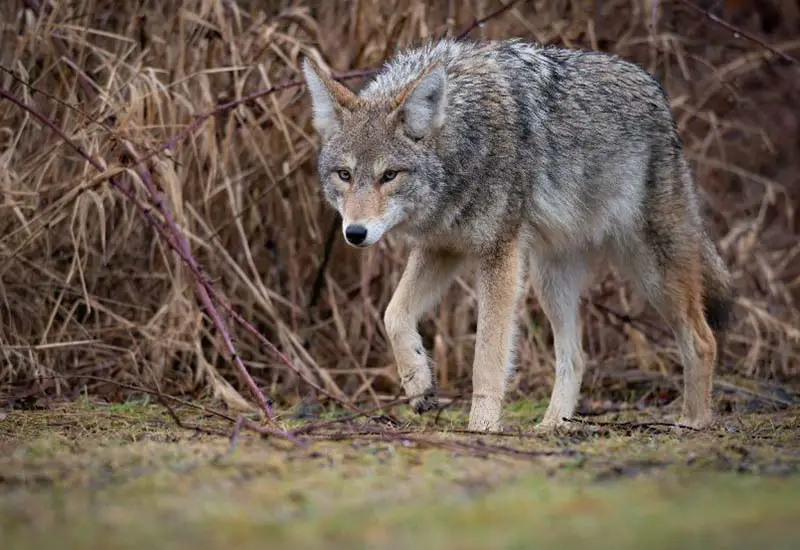Coyotes in CT: Population, Hunting Rules & How to Avoid Conflict
With an estimated population of almost 5,000, Coyotes are quite common in Connecticut. But what should you do if you see one? And, are you allowed to hunt coyotes in CT?
This guide will cover everything you need to know about coyotes in Connecticut, including how to identify them and hunting regulations. I’ll also cover what to do if you encounter one, so you can avoid conflict.

What Towns have the most Coyotes in Connecticut?
The total population of coyotes in Connecticut is estimated to be between 3,000 and 5,000. That population of spread throughout the entire state, so there is no single concentration of coyotes in any one town. You can find them anywhere, including in wooded suburbs, parks, and beaches.
However, this wasn’t always the case. The coyote population has exploded in the past 100 years, as they have migrated from other parts of the county. But coyotes aren’t native to Connecticut.
In fact, wolves are native to CT but were overhunted in the 1700s. After the wolves were wiped out, coyotes replaced them in the ecosystem. Coyotes are simply better suited to survive in modern Connecticut since they are more adapted to coexist with humans.
Types of Coyotes in CT
There are several different species of coyote in the United States, but the ones that live in Connecticut are called eastern coyotes, or coywolves. Coywolves are a genetic mix between a coyote and a wolf.
These coywolves are about the same size as normal coyotes (about 25-50 pounds in weight), however, their behavior is similar to wolves. They have a much larger home range than the typical coyote and tend to be more social with each other. You will often hear them bark, howl, and yip with one another.
What to do if You See a Coyote in CT
Eastern coyotes don’t usually pose a threat to adult humans, however, they can attack dogs and small children. With that being said, attacks are increasing in areas where coyotes are accustomed to humans. They can also carry rabies, so they aren’t animals that you want to mess around with.
To scare coyotes away, you should try to be as big and loud as possible. Yelling, stomping your feet, and banging pots and pans together are all good ways to scare off a coyote (this tactic is often called hazing). Throwing rocks at their feet can also scare them away.
The only thing you don’t want to do is turn your back and run. If a coyote is being aggressive, the best course of action is to put your hands in the air and make noise while slowly backing away. Do not try to outrun a coyote, as they can reach speeds of 40 mph.
How to Keep Coyotes Away
Coyotes typically only show aggression towards smaller animals, but they can still be a nuisance. Here are some tips to deter coyotes from your property.
- Never feed coyotes. They will become bold as they get used to humans.
- Keep pets indoors at night.
- Fill any potential den sites in your yard.
- Don’t leave pet food outdoors.
- Put a cover on all garbage cans outside.
- Keep your dogs on a leash when walking them.
- Install fencing around your yard (at least 8 ft high and 1.5 ft deep).
Coyotes commonly use sheltered areas like burrows, hollow trees, and thick underbrush as dens, however, you can also find them sleeping under sheds and decks too. It’s important that you scare them away before they breed. CT Coyotes have an average of 7 pups per litter.
If you see coyotes exhibiting aggressive or abnormal behavior, it’s best to report the sighting to your local animal control office or to Connecticut’s DEEP Wildlife Division.
Rules for Hunting Coyotes in Connecticut
It is legal to hunt and trap coyotes in Connecticut. The coyote hunting season spans the entire year, and there is no daily or seasonal limit. The only real limitation is that you can’t hunt Connecticut coyotes at night.
Coyotes killed through hunting or trapping must be reported to the state online or by telephone. You can also pelt tag a coyote if you plan on selling it. Just know that Sunday hunting is limited in some parts of CT.
If you have a coyote on your property, you can shoot it if the animal has been causing property damage or is a threat to public health and safety. Holders of a firearms hunting license can use rifles, shotguns, handguns, muzzleloaders, and high-velocity air guns, to hunt coyotes.
Coyote Hunting Tactics
Coyotes are most active at night and in the early morning, so this is the best time to hunt them. However, since night hunts are prohibited in Connecticut, you want to hunt around sunrise and sunset.
The best way to hunt a coyote in Connecticut’s woods is to either use bait or set up a decoy with an electronic calling device. You will be most effective if you can set up near the coyote’s den.
Coyotes normally eat rodents like mice, squirrels, rabbits, turkeys, woodchucks, deer, and some fruits. If you have anything left over from a deer hunt, that is perfect for your coyote bait pile. One deer can supply you with coyote bait for the entire season.
Connecticut’s Coyote Problem – Final Thoughts
Coyote sightings are quite common in Connecticut, however, coyote attacks on humans are very rare. You should be more concerned about the safety of outdoor pets and livestock than anything else.
You can avoid most problem coyotes by setting up fences around your house and hiding food sources. As an extra measure, you can prevent potential denning by making the habitat around your home undesirable to coyotes.
